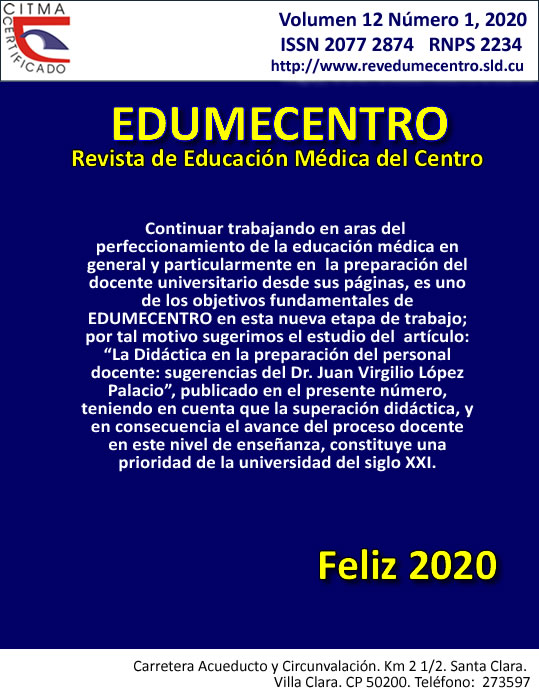Teaching training to prevent cardiovascular risk indicators in Santa Clara students
Keywords:
risk factors, health status indicators, risk assessment, research design, strategies, health promotion, school health servicesAbstract
Background: high blood pressure and obesity in the pediatric age exhibit high levels of prevalence worldwide, including Cuba, which bases its early diagnosis to reduce its effects at these ages and its impact on adulthood.
Objective: to develop an educational strategy aimed at improving the teaching work to promote an adequate health culture among schoolchildren.
Methods: a cross-sectional descriptive and prospective epidemiological study was developed that included the calculation of obesity and the test of sustained weight in schoolchildren of several primary schools. Theoretical methods were used: analysis-synthesis, induction-deduction and systemic-structural; empirical ones: documentary analysis and surveys to schoolchildren, teachers and family; and the mathematical-statistic for the analyzed values.
Results: in the clinical diagnosis a high prevalence of cardiovascular risk factors was found, in figures related to high blood pressure, body overweight, obesity, and cardiovascular hyperactivity; while the educational diagnosis allowed knowing deficiencies in the teaching preparation and in the family of schoolchildren on topics as healthy habits and lifestyles, so an educational strategy was developed and applied to offer a solution to the problem.
Conclusions: the strategy allowed teachers to provide the necessary knowledge and means to promote healthy lifestyles, inside the curriculum and out of it where methodological work was strengthened by integrating these issues into the teaching-learning process, which led to the development of a necessary health culture in the students.
Downloads
Published
How to Cite
Issue
Section
License
Los autores que publican en esta revista están de acuerdo con los siguientes términos:- Los autores/as conservarán sus derechos de autor y ceden a la revista el derecho de primera publicación de su obra, el cuál estará simultáneamente sujeto a una Licencia Creative Commons Reconocimiento-NoComercial-CompartirIgual 4.0 Internacional (CC BY-NC-SA 4.0) que permite a terceros compartir la obra siempre que se indique su autor y su primera publicación esta revista.
- Los autores pueden establecer por separado acuerdos adicionales para la distribución no exclusiva de la versión de la obra publicada en la revista (por ejemplo, situarlo en un repositorio institucional o publicarlo en un libro), con un reconocimiento de su publicación inicial en esta revista.
- Se permite y se anima a los autores a difundir sus trabajos electrónicamente (por ejemplo, en repositorios institucionales o en su propio sitio web) antes y durante el proceso de envío, ya que puede dar lugar a intercambios productivos, así como a una citación más temprana y mayor de los trabajos publicados (Véase The Effect of Open Access) (en inglés).









